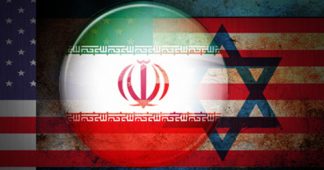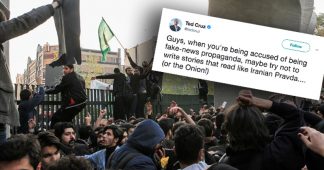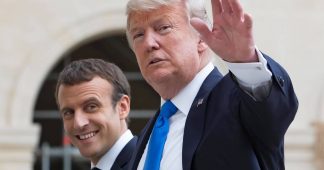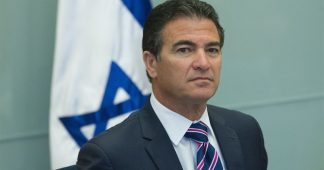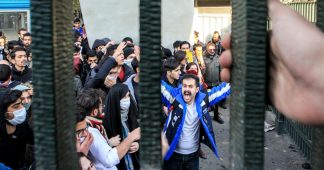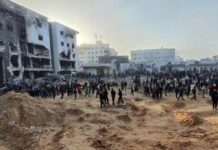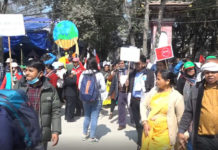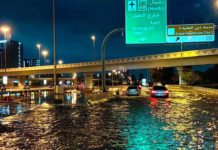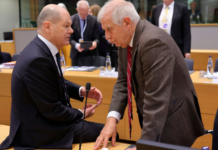By Ariane Tabatabai
5 April 2018
In the summer of 2009, when millions of protesters took to the streets of Iranian cities, the way they used social media to organize and disseminate information made headlines around the globe. That season’s unrest, sparked by the fraudulent reelection of hardline President Mahmoud Ahmadinejad, became known as the Green Movement. It faded after a few months, and the Islamic Republic soon outlawed major social media platforms. Twitter and Facebook have remained banned in Iran ever since. Iranians continue to use various software programs to bypass the regime’s filtering, though, and some regime officials and institutions retain their access, using social media to communicate with their constituents and the outside world. Besides Facebook and Twitter, Instagram and the messaging app Telegram are also popular.
So while the Iranian regime remains officially opposed to social media, some regime officials are active on these platforms. Many are hardliners, who make up the most conservative faction within the Islamic Republic (though not always a cohesive one). Their world view values a tight grip on society by the clerical and security establishments, severe limitations on civil rights, little engagement with the West and none with the United States, and opposition to the 2015 nuclear deal between Iran and six world powers, known as the Joint Comprehensive Plan of Action or JCPOA.These hardliners’ social media activity has gone largely unnoticed in the West, but it provides insight into their thinking. A look into the hundreds of accounts affiliated with hardline voices sheds important light on the domestic dynamics surrounding the nuclear deal. They are particularly worth examining as the nuclear agreement enters an even more vulnerable phase, with US officials seeking to undermine or end it, and in Iran, intensified infighting between moderates and reformists on one side and hardliners on the other.
Iranian fake news. In Iran as in the rest of world, fake news, propaganda, and conspiracy theories pre-date the advent of social media. Like people in other parts of the Middle East, Iranians are prone to conspiracy theories, particularly those pertaining to the role of foreign powers in the region. To be sure, foreign involvement has long been a real part of daily life in the Middle East. But as visitors to the region are quick to realize, myths about foreign involvement also exist, and they are both pervasive and bewildering. In fact, fake news built on conspiracy theories about foreign meddling helped drive the 1979 Islamic Revolution. The revolutionaries used the technology available to them back then—often cheap, low-tech means like cassette tapes, flyers, and leaflets—to disemminate fake news to the masses. For example, when an earthquake shook the city of Tabas in 1978, some revolutionaries blamed the quake on Western countries having dumped nuclear waste in the nearby Lut Desert, while others pontificated that it was caused by American underground nuclear tests. And the fake news didn’t begin with the revolution. As far back as the early 1970s, the novel Daei Jan Napoleon and the TV series based on it—now a beloved piece of pop culture consumed by generations of Iranians—satirized widespread conspiracy theories pertaining to the British presence and influence in Iran. Social media platforms, though, have made it much easier to create and spread fake news and conspiracy theories, and to reach an increasingly large and diverse target audience.
Who is behind the accounts? The social media accounts I have examined can be divided into four categories. First, there are the authorized accounts of hardline regime officials—such as former nuclear negotiator Saeed Jalili, who led Ahmadinejad’s nuclear talks with the Americans in 2012, and other current and former members of parliament, government, and the armed forces. These accounts indicate the faction’s official hawkish line. Their existence is perplexing, as Iran has outlawed and filters major social media platforms, but this limitation doesn’t appear to apply to regime officials—even as they periodically revive ideas on how to further restrict internet tools.
Second, since the start of the Iranian campaigns in Iraq and Syria, which are aimed at pushing back the Islamic State (ISIS) and propping up the regime of Syrian dictator Bashar al-Assad, accounts affiliated with Iran’s paramilitary powerhouse, the Revolutionary Guards, have proliferated rapidly. While some of these accounts clearly identify with elements of the Guards, such as its air force, ground forces, navy, or special operations units, others simply disseminate content that is not necessarily sanctioned by the Guards, but falls in line with their world view.
Third, a number of “news and analysis” outlets operate on the Persian-language internet, including on social media. While some of these outlets are official and well-known in the country and around the globe, such as the Revolutionary Guards-affiliated website Tasnim, others do not have clear affiliations.
Fourth, thousands of individuals with no clear affiliation or position roam the platforms, often disseminating highly partisan content, including harsh criticism and even mockery of moderates and reformists. By and large, the official or semi-official outlets steer clear of explicit ad hominem attacks, merely focusing on themes and specific issues, while making it clear whose policies they are targeting. But accounts in this last category name and shame.
Specifically, these unaffiliated hardline accounts target several categories of individuals and groups. They denounce reformists and moderates, either by deploying disinformation campaigns or simply by highlighting words and deeds they deem un-Islamic, counter to the values of the Iranian Revolution, or against the public interest. They also target intellectuals, artists, and those who have advocated for better ties with the West. Even when individuals are not named directly, the broader public does not escape the hardliners, with their accounts portraying people outside their base as superficial, unpatriotic, and outright corrupt.
Means and messages. Hardliners use videos, photos, memes, quotes, and charts to drive their message home. They often juxtapose photos of good and bad outcomes, or individuals they deem good and bad. Each item is accompanied by several hashtags, making it easier to find the material. And while each account usually has its own unique content, the same themes and grievances appear across multiple accounts. Most of the postings are in Persian, although they do frequently feature Arabic-language material, particularly religious content. The accounts also occasionally present English-language material. (Regime-affiliated websites frequently offer the option to view content in several languages, but this is less often the case on social media).
These days the JCPOA is a frequent topic, with several subthemes dominating hardline content on Instagram and Telegram. The nuclear agreement remains one of the most significant and controversial foreign policy issues in contemporary Iranian history. The moderates and reformists, championed by President Hassan Rouhani and his chief negotiator, Foreign Minister Javad Zarif, continue to hail the deal as a win-win solution to the nuclear crisis. For them, the JCPOA didn’t just remove the international sanctions that stymied their country’s economic life, it also paved the way for Iran’s reentry into the world community while ridding it of the threat of war. But Iranian hardliners see the nuclear deal differently. From their point of view, the country made a number of concessions that weakened its hard-won nuclear infrastructure, for very little in return. Hardline social media accounts make this view clear, in thousands of posts aimed at discrediting the JCPOA and pressuring Rouhani and his team. Several major themes emerge.
Trust in weapons, not talks. First, Iranian hardliners distrust negotiations as a tool to settle foreign policy matters. They draw on historical examples to note that their country has never had a fair shot or positive outcome in negotiations. In a popular meme on their Instagram accounts, as illustrated below, they remind their compatriots that the Qajar dynasty of 1785 to 1925—responsible for losing chunks of the country to various powers, particularly Russia and Britain, thereby shaping the map of modern Iran—lost territories “not through war but with treaties by Iranian statesmen who [wanted to] negotiate.”
Read more at https://thebulletin.org/what-are-iranian-hardliners-saying-social-media11660
Published at https://thebulletin.org/what-are-iranian-hardliners-saying-social-media11660
